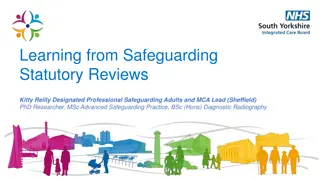Understanding the Importance of Quality Literature Reviews in Learning and Development
Exploring the characteristics of quality literature reviews is essential for academic development. Differentiating between weak and strong reviews, understanding critical engagement, and identifying themes can enhance research and practice. A detailed example illustrates the significance of user needs in online manuscript collections within a broader context of web usability.
Download Presentation

Please find below an Image/Link to download the presentation.
The content on the website is provided AS IS for your information and personal use only. It may not be sold, licensed, or shared on other websites without obtaining consent from the author. Download presentation by click this link. If you encounter any issues during the download, it is possible that the publisher has removed the file from their server.
E N D
Presentation Transcript
Recognising Quality Literature Reviews Learning Development
Learning outcomes To develop the ability to identify high quality examples of literature review content To further understand the purpose of a literature review To understand that literature reviews should be critical, not descriptive pieces
Quality literature reviews A weaker literature review: lists key findings without critical engagement describes content of literature addresses individual articles or books without looking for similarities or differences between other articles uses disciplinary terminology without explanation or definition
Quality literature reviews A quality literature review: avoids description provides context explains why this report/essay/dissertation is important within that context offers critical insight (strengths and weaknesses) identifies themes within the existing literature which can inform research and practice
Example 1 As an emerging resource, it is important that we gain a proper understanding of what does and does not work when presenting historic documents online, whether for an academic or general audience. Indeed, understanding the needs of the user is paramount to web usability in general. As such, the UK government has placed the concept of understanding user needs and what that means for the design of the service as the first point in its 18-point Digital Service Standard guidelines. This literature review surveys the existing research on online manuscript collections, first to explore current observations of good practice and, second, to identify criteria that will be used in the evaluation of the chosen online archive databases for this project. Is this a good or bad example of a literature review?
Example 1 As an emerging resource, it is important that we gain a proper understanding of what does and does not work when presenting historic documents online, whether for an academic or general audience. Indeed, understanding the needs of the user is paramount to web usability in general. As such, the UK government has placed the concept of understanding user needs and what that means for the design of the service as the first point in its 18-point Digital Service Standard guidelines. This literature review surveys the existing research on online manuscript collections, first to explore current observations of good practice and, second, to identify criteria that will be used in the evaluation of the chosen online archive databases for this project. This is part of an introduction. It provides a clear statement of what the literature review s purpose is and provides some initial context It makes it clear that the literature review will identify criteria that has a purpose for the remainder of the report.
Example 2 Max Weber introduced the concept of Iron Cage Rationality. He divided rationality into two divisions: rational and non-rational decisions. Rational decisions include calculation and efficiency and focuses on results. Non- rational decisions include values, morals and traditions. Unlike rational decisions, non-rational decisions are focused on the process of decision- making rather than the end results. Weber believed rationalisation is a key aspect of modernisation. Is this a good or bad example of a literature review?
Example 2 Max Weber introduced the concept of Iron Cage Rationality. He divided rationality into two divisions: rational and non-rational decisions. Rational decisions include calculation and efficiency and focuses on results. Non- rational decisions include values, morals and traditions. Unlike rational decisions, non-rational decisions are focused on the process of decision- making rather than the end results. Weber believed rationalisation is a key aspect of modernisation. While this paragraph offers a lot of detail, it is very descriptive and simply lists key details It fails to expand on or define some of its key terminology The author has not connected this to other literature for context
Example 3 Broadly speaking, there is consensus within the literature that there are three key parameters to measuring the success of a project: quality, cost and time, referred to as the Golden Triangle of project management or as the dimensions of success for information systems. As such, a project always begins with the requirements of the people: the users, stakeholders and the project team itself. Indeed, it has been noted that there are six key areas to managing a project: first setting up the project, then managing the schedule, the finances, the benefits, the risks, opportunities and issues, and, finally, seeking independent review. Is this a good or bad example of a literature review?
Example 3 Broadly speaking, there is consensus within the literature that there are three key parameters to measuring the success of a project: quality, cost and time, referred to as the Golden Triangle of project management or as the dimensions of success for information systems. As such, a project always begins with the requirements of the people: the users, stakeholders and the project team itself. Indeed, it has been noted that there are six key areas to managing a project: first setting up the project, then managing the schedule, the finances, the benefits, the risks, opportunities and issues, and, finally, seeking independent review. This paragraph synthesises existing research to create a list of points for discussion within the report The rest of the report can then follow what has been set out in the literature review giving this section real purpose and meaning
Example 4 The metacognitive model explains the causes of obsessive compulsive disorder (OCD). Metacognition is referred to as an awareness about one's thought processes and the strategies used to regulate those. There are two categories of belief that are evident in maintaining OCD. The first covers the three types of metacognitive beliefs about intrusive thoughts. The second belief is that of the necessity to perform the ritual and the negative consequences for failing to do that. Is this a good or bad example of a literature review?
Example 4 The metacognitive model explains the causes of obsessive compulsive disorder (OCD). Metacognition is referred to as an awareness about one's thought processes and the strategies used to regulate those. There are two categories of belief that are evident in maintaining OCD. The first covers the three types of metacognitive beliefs about intrusive thoughts. The second belief is that of the necessity to perform the ritual and the negative consequences for failing to do that. This passage does not provide context or link the work to existing literature The tone is very descriptive and reads like a list of features of the model It does not offer a full evaluation, it simply describes what it is
Example 5 In contrast to the more Westminster-centric work of influential Tudor historians, perhaps most notably Geoffrey Elton, the work of later historians, including Penry Williams and John Guy, has given much more weight and attention to the role of the county gentry. Indeed, having explored the court and its controversies, the natural step for political historians was to move outwards from Westminster - the heart of the body politic - to the counties to view the court and country from afar, the most successful examples of which being Cheshire, Kent and Suffolk. Is this a good or bad example of a literature review?
Example 5 In contrast to the more Westminster-centric work of influential Tudor historians, perhaps most notably Geoffrey Elton, the work of later historians, including Penry Williams and John Guy, has given much more weight and attention to the role of the county gentry. Indeed, having explored the court and its controversies, the natural step for political historians was to move outwards from Westminster - the heart of the body politic - to the counties to view the court and country from afar, the most successful examples of which being Cheshire, Kent and Suffolk. This paragraphs clearly raises commonly studied areas within the discipline and identifies a less well explored area in need of further research Usefully, it gives examples of successful studies which the author goes on to examine. It is also helpfully mentions the work of three prominent academics to substantiate the point























